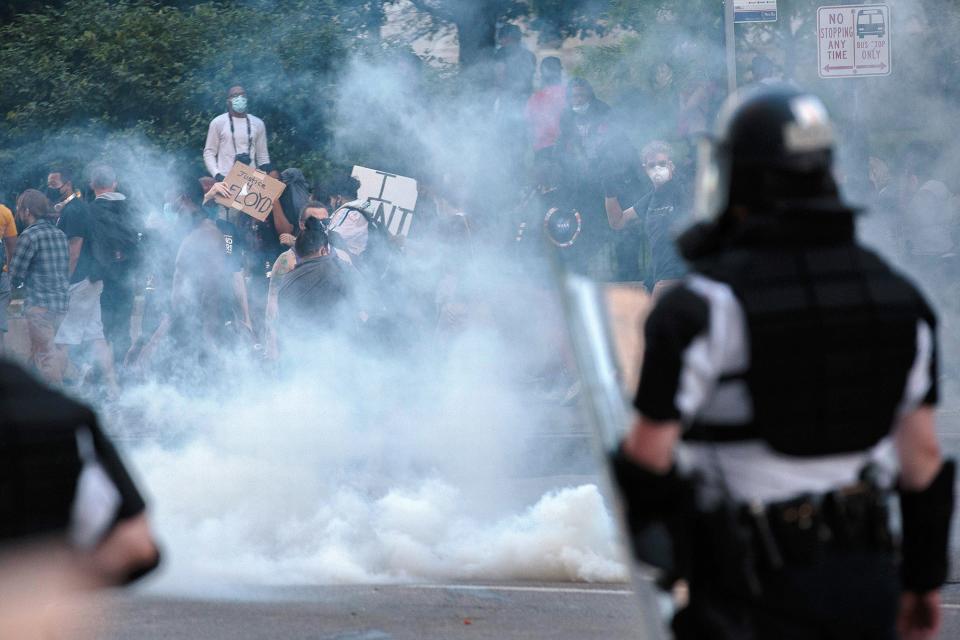Columbus City Council unanimously OKs limits on police use of force against protesters
- Oops!Something went wrong.Please try again later.

The divided Columbus City Council from late 2020 transformed into a harmonious panel Monday night when members unanimously passed President Pro Tem Elizabeth Brown's restrictions on police use of force against protesters, a measure that had been tabled for almost two years.
While the measure had previously stalled on a 4-3 vote in September 2020, two of those votes to table flipped to "yes" votes on Monday: Council President Shannon Hardin and member Emmanuel Remy, who chairs the council's public safety committee. The two other members voting to table in 2020 — Priscilla Tyson and Mitchell Brown, a former city public safety director — retired from office at the end of last year.
Like the earlier version, the ordinance restricts Columbus police from using tear gas, pepper spray and other "control agents" to disperse non-violent protesters, while placing limits on so-called "less-lethal" weapons such as rubber and wooden bullets.
Columbus police actions in 2020 protests led to use of force ordinance
Following racial justice protests and some rioting in the spring of 2020, the Columbus Division of Police's aggressive response resulted in at least $5.75 million in city tax dollars going to pay federal court settlements for violating the civil rights of protesters who were injured. Police actions also led to the creation of a new Civilian Police Review Board and contributed to a massive shakeup in the police division's top leadership as military-like practices and equipment used by officers whose badges and identification were often obscured came under a spotlight.

"The way we equip our police force came under new scrutiny, and the public weighed in in a big way," Brown said during the council meeting Monday evening.
"This effort is really a demonstration of the city that we are going to protect First Amendment rights, but we are really going to be clear about the rules. ... I really believe that this legislation helps our police division better embody the peacekeeping that's at the heart of every officer's role, and at the heart of why I believe most officers sign up for serving in the first place."
Hardin applauded Brown's leadership on the issue before the vote, but offered no explanation as to why he voted with a 4-3 majority to table a very similar measure 21 months ago after signing on as a co-sponsor. His name was dropped from the new measure approved Monday.

The Dispatch made a request with Hardin's office immediately following Monday's meeting to explain his two differing votes since the city and Columbus police subsequently agreed to a federal court settlement that already put many of the same limits on what force they can use on non-violent protesters.
Brown mainly pointed to that federal court ruling "that First Amendment rights are foundational and nonviolent protesters cannot be met with force," she said in an email following the vote. "Additionally, it carried weight that the public safety department supported the whole ordinance, including the updated provision regarding helicopters," which now must try to operate more quietly, staying away from residential areas when not responding to a call.
During a joint appearance while pushing the council's "Reimagining Public Safety" initiative in summer 2021, Brown and Hardin seemed to speak from different pages on the topic.
"There's been more anger than praise (for police) in the last year, and I get that, but we need to keep on marching," Hardin said in prepared remarks highlighting the need for the community to re-engage with police or face growing violence, including new homicide records each year.
"We didn't fix everything, it's not perfect," Hardin said then. "... But now is the time to come back together."
Brown, however, used the event to continue to hammer home the need for her reforms, saying she was inspired by Chief U.S. District Judge Algenon L. Marbley of the U.S. District Court for the Southern District of Ohio in Columbus, who had said Columbus police had "run amok" against protesters when he granted a preliminary injunction barring tear gas, pepper spray, wooden bullets and common tactics.
While the city had launched numerous anti-crime programs, "altogether, none of it will work without establishing base trust, and I think we have a great deal of work to do there," Brown said at the event.
What are the restrictions on Columbus police?
Much of the new Brown ordinance closely follows what became Marbley's permanent injunction agreed to by the Division of Police, with many of the same restrictions on what methods can be employed against non-violent protesters. But most of the rest of the ordinance is exact or largely similar language from the 2020 measure.
The newly approved ordinance limits armored vehicles and "explosives and pyrotechnics" to tactical SWAT police units, limits the use of rifles to "critical incidents," and requires an annual report from the police chief to council on police use of force, among other things.
The Columbus Department of Public Safety supports the ordinance, as it now codifies what are its internal standards. The department "will work diligently to uphold the standards set forth in this legislation, and the communities' expectations," said Tim Williams, deputy director of Public Safety.
A companion ordinance sponsored by Council member Rob Dorans, which also passed unanimously Monday evening, requires police officers' names and badge numbers be displayed on their uniforms while on duty, even when wearing "alternative uniforms or riot gear."
Dorans said at the start of the 2020 protests that police weren't doing this, and it "created a situation where it was extremely difficult to investigate citizen complaints." He called the ordinance a practical, common-sense fix that will protect officer misidentification and potential discipline for the actions of someone else. Police working undercover are exempt.
"I truly believe that will benefit officers so that no one is a subject of a complaint because they were confused with another officer," Dorans said.
The police division had started attaching tape with officers' names on it in response to complaints early on during the protests, and new riot gear contains places for identification.
Adrienne Hood, whose son Henry Green was fatally shot by plainclothes Columbus police officers in 2016 during an exchange of gunfire exactly six years before Monday's vote, told council on Monday that "there's still a lot of work to be done, but this is a great start."
"The protests of 2020 was the outcry of the community saying enough is enough," Hood said. "But instead of being allowed to peacefully protest, the protesters were met with riot gear and militarized weapons and equipment."
A Franklin County grand jury chose not to indict the two officers involved in Green's death. Hood is appealing a federal jury's verdict that determined the two officers did not use excessive force in the shooting, rejecting a civil rights lawsuit seeking damages in her son's death.
wbush@gannett.com
@ReporterBush
Get more political analysis by listening to the Ohio Politics Explained podcast
This article originally appeared on The Columbus Dispatch: Columbus police use of force against protests now limited by city law

